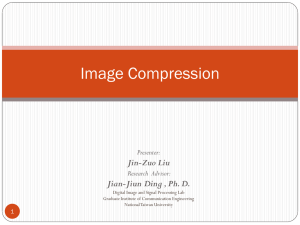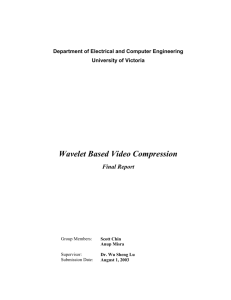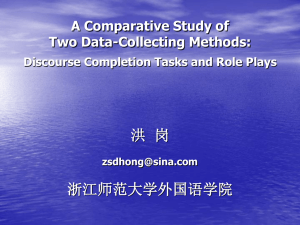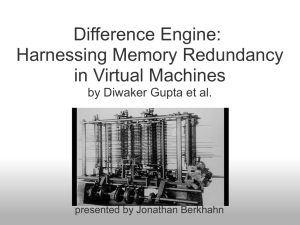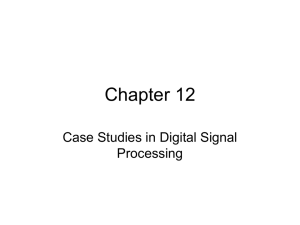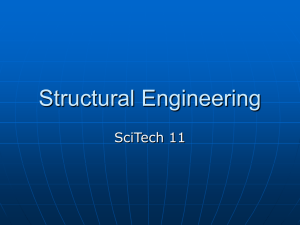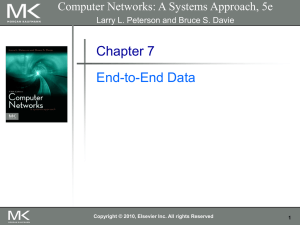Tong Qiao Seminar 2013
advertisement
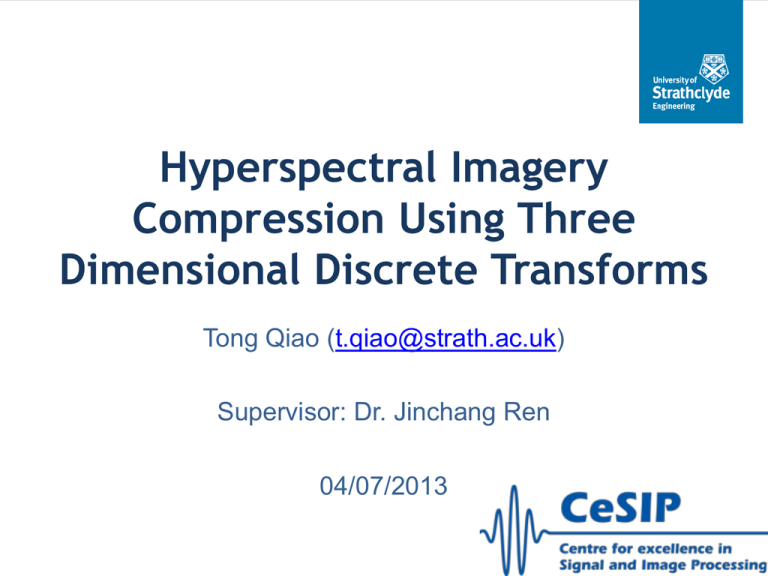
Hyperspectral Imagery Compression Using Three Dimensional Discrete Transforms Tong Qiao (t.qiao@strath.ac.uk) Supervisor: Dr. Jinchang Ren 04/07/2013 Structure • Introduction to hyperspectral imagery • 3D discrete wavelet transform (DWT) based compression • 3D discrete cosine transform (DCT) based compression • Performance comparison • Conclusion Hyperspectral Imagery • High definition electro-optic images with hundreds of spectral bands • Applications: Fig.1: Hyperspectral image acquired over Moffett Field (CA, USA) – – – – Remote sensing Military surveillance Food quality analysis Pharmaceutical Hyperspectral Imagery • Problems – Huge amount of data – High cost for storage and transmission • Therefore, COMPRESSION is needed. Principles of Compression • Compression – Lossless (Compression ratio of 3:1) – Lossy (Compression ratio of 50:1 or more) • Transform coding • Transform coding – DWT based compression • JPEG 2000 standard – DCT based compression • JPEG standard 3D DWT Based Compression Fig.2: The 3D discrete wavelet transform 3D DWT Based Compression • Wavelet filter – Cohen-Daubechies-Feauveau (CDF) 9/7-tap filter (lossy compression) – CDF 5/3-tap filter (lossless compression) Fig.3: 3D dyadic DWT with 2 decomposition levels 3D DWT Based Compression • Encoding stage – 3D SPIHT ( Set Partitioning in Hierarchical Trees) • No child at the root node in the highest level • Each of other 7 nodes has a 2 x 2 x 2 child cube directing to the same spatial orientation in the same level • Except at highest and lowest levels, a pixel will have 8 offspring in the next level. Fig.4: 3D parent-child relationships between subbands of a 3D DWT 3D DWT Based Compression • 3D SPIHT algorithm – Initialisation • List of Insignificant Sets (LIS) • List of Insignificant Pixels (LIP) • List of Significant Pixels (LSP) – Coding passes • Sorting pass • Refinement pass – Coefficients and trees are stored in lists processed in sequence 3D DWT Based Compression • Entropy encoding – But only a little improvement – This step is left out. 3D DCT Based Compression • Adapted from JPEG standard • Equation: F (u, v, w) 2 2c(Nu)cN(v)c(w) f ( x, y, ) cos(22xN 1 u ) cos(22yN 1 v ) cos(22N 1 w ) N 1 N 1 N 1 x 0 y 0 0 u, v, w 0,1,..., N 1 1 ,k 0 c(k ) 2 1, k 0 • Block diagram 8x8x8 block DCT Quantisation Table Coding Tables Quantiser Entropy Encoder Lossy Compressed Data 3D DCT Based Compression • Quantisation 𝐹 𝑢, 𝑣, 𝑤 𝐶 𝑢, 𝑣, 𝑤 = 𝑟𝑜𝑢𝑛𝑑 𝑄 𝑢, 𝑣, 𝑤 • Dequantisation 𝑅 𝑢, 𝑣, 𝑤 = 𝐶(𝑢, 𝑣, 𝑤) × 𝑄 𝑢, 𝑣, 𝑤 3D DCT Based Compression • Quantisation table for hyperspectral images 𝑄50 = 𝑟𝑜𝑢𝑛𝑑 𝑢 + 𝑣 + 𝑘𝑤 + 3 – k: [0, 8] – Weak inter-band correlation: lower k – Strong inter-band correlation: higher k 3D DCT Based Compression • Quality level (q) – q: [1,99] 𝑄 𝑢, 𝑣, 𝑤 = 100−𝑞 × 𝑄50 50 50 × 𝑄50 𝑞 𝑞 > 50 𝑞 < 50 3D DWT Based Compression • Encoding stage – Huffman encoder – DC coefficients • Differential coding • Diff = DCi – DCi-1 Fig.5: The differential coding of DC coefficients – AC coefficients • 3D zig-zag scanning order • Run-length coding Performance Comparison • Four datasets Fig.6: Moffett field Fig.8: Salinas valley and its ground truth Fig.7: Indian pines and its ground truth Fig.9: Pavia University and its ground truth Performance Comparison • Subjective assessment – Compression bit rate = 0.1 bpppb – Left: DWT, right: DCT Performance Comparison • Subjective assessment – Compression bit rate: 0.2, 0.5, 0.8 and 1 bpppb – Top: DWT, bottom: DCT Performance Comparison • Objective assessment – Rate-distortion measurement • SNR (Signal-to-Noise Ratio) vs. bit rate Moffett field 40 35 SNR (dB) 30 25 20 DWT 15 DCT 10 5 0 0.1 0.2 0.3 0.4 0.5 0.6 0.7 Compression bit rate (bpppb) 0.8 0.9 1 Performance Comparison • Objective assessment Indian pines 40 35 SNR (dB) 30 25 20 DWT 15 DCT 10 5 0 0.1 0.2 0.3 0.4 0.5 0.6 0.7 Compression bit rate (bpppb) 0.8 0.9 1 Performance Comparison • Objective assessment SNR (dB) Salinas valley 45 40 35 30 25 20 15 10 5 0 DWT DCT 0.1 0.2 0.3 0.4 0.5 0.6 0.7 Compression bit rate (bpppb) 0.8 0.9 1 Performance Comparison • Objective assessment Pavia University 40 35 SNR (dB) 30 25 20 DWT 15 DCT 10 5 0 0.1 0.2 0.3 0.4 0.5 0.6 0.7 Compression bit rate (bpppb) 0.8 0.9 1 Performance Comparison • Quality-assured assessment – SVM (Support Vector Machine) – 50% for training and 50% for testing – Optimal models are learnt from original images, then applied to reconstructed images Performance Comparison • Quality-assured assessment Indian pines 100.00% Prediction accuracy 90.00% 80.00% 70.00% 60.00% DWT 50.00% DCT 40.00% Original 30.00% 20.00% 0.1 0.2 0.3 0.4 0.5 0.6 0.7 Bit rate (bpppb) 0.8 0.9 1 Performance Comparison • Quality-assured assessment Salinas Valley Prediction accuracy 100.00% 95.00% 90.00% 85.00% DWT 80.00% DCT 75.00% Original 70.00% 65.00% 0.1 0.2 0.3 0.4 0.5 0.6 0.7 Bit rate (bpppb) 0.8 0.9 1 Performance Comparison • Quality-assured assessment Pavia University 100.00% Prediction accuracy 95.00% 90.00% 85.00% 80.00% DWT 75.00% DCT 70.00% Original 65.00% 60.00% 0.1 0.2 0.3 0.4 0.5 0.6 0.7 Bit rate (bpppb) 0.8 0.9 1 Conclusion • 3D DCT has great potential to produce better compression than 3D DWT • 3D DCT based compression of hyperspectral imagery at a bit rate of no less than 0.5 bpppb is feasible Thank you! Questions?


